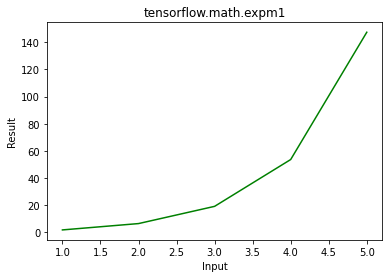Python – tensorflow.math.expm1()
Last Updated :
08 Jun, 2020
TensorFlow is open-source Python library designed by Google to develop Machine Learning models and deep learning neural networks.
expm1() is used to compute element wise exp(x)-1.
Syntax: tensorflow.math.expm1( x, name)
Parameters:
- x: It’s the input tensor. Allowed dtypes are bfloat16, half, float32, float64, complex64, complex128.
- name(optional): It defines the name for the operation.
Returns: It returns a tensor of same dtype as x.
Example 1:
Python3
import tensorflow as tf
a = tf.constant([1, 2, 3, 4, 5], dtype = tf.float64)
print('Input: ', a)
res = tf.math.expm1(x = a)
print('Result: ', res)
|
Output:
Input: tf.Tensor([1. 2. 3. 4. 5.], shape=(5, ), dtype=float64)
Result: tf.Tensor([ 1.71828183 6.3890561 19.08553692 53.59815003 147.4131591 ], shape=(5, ), dtype=float64)
Example 2: Visualization
Python3
import tensorflow as tf
import matplotlib.pyplot as plt
a = tf.constant([1, 2, 3, 4, 5], dtype = tf.float64)
res = tf.math.expm1(x = a)
plt.plot(a, res, color ='green')
plt.title('tensorflow.math.expm1')
plt.xlabel('Input')
plt.ylabel('Result')
plt.show()
|
Output:

Share your thoughts in the comments
Please Login to comment...